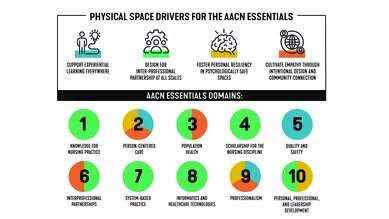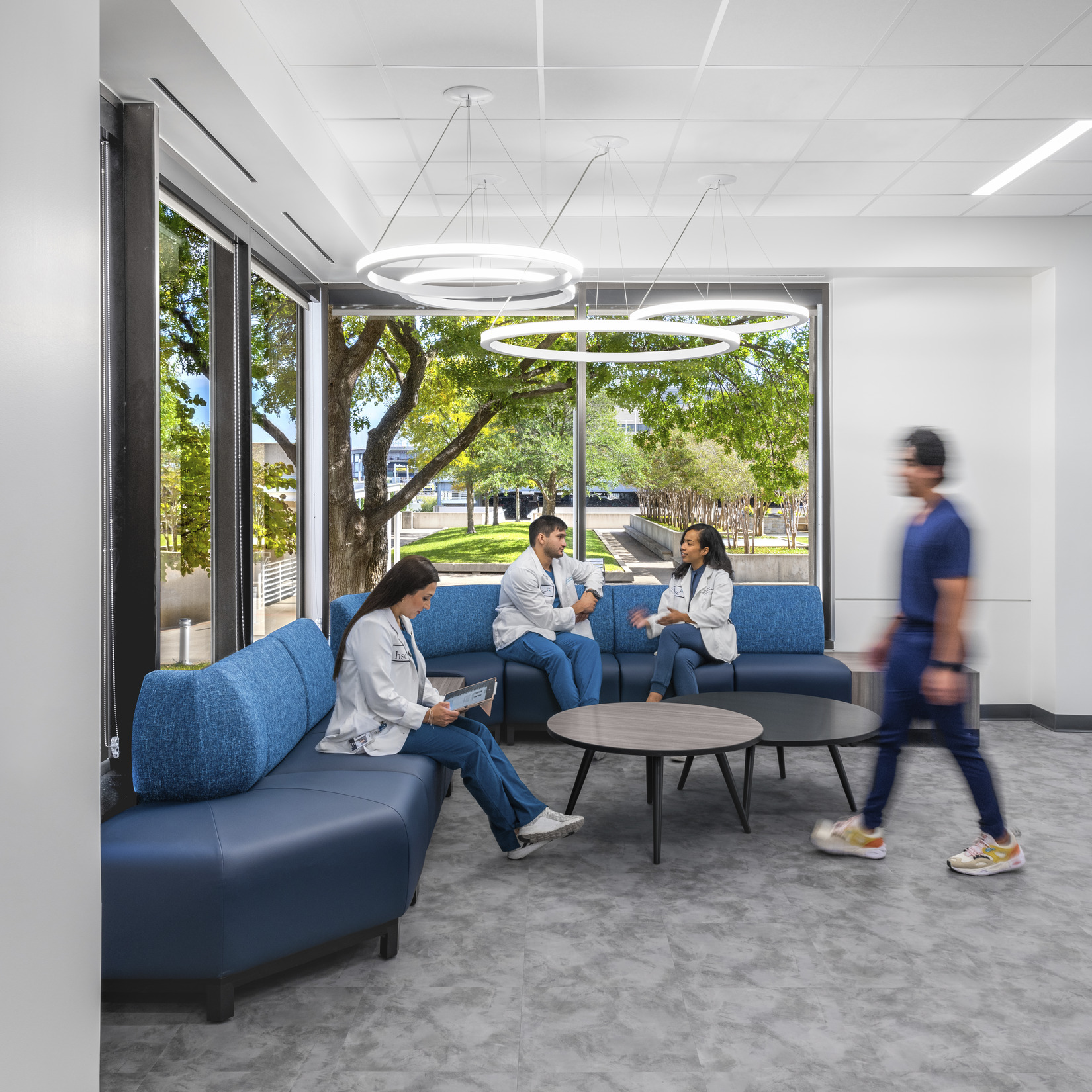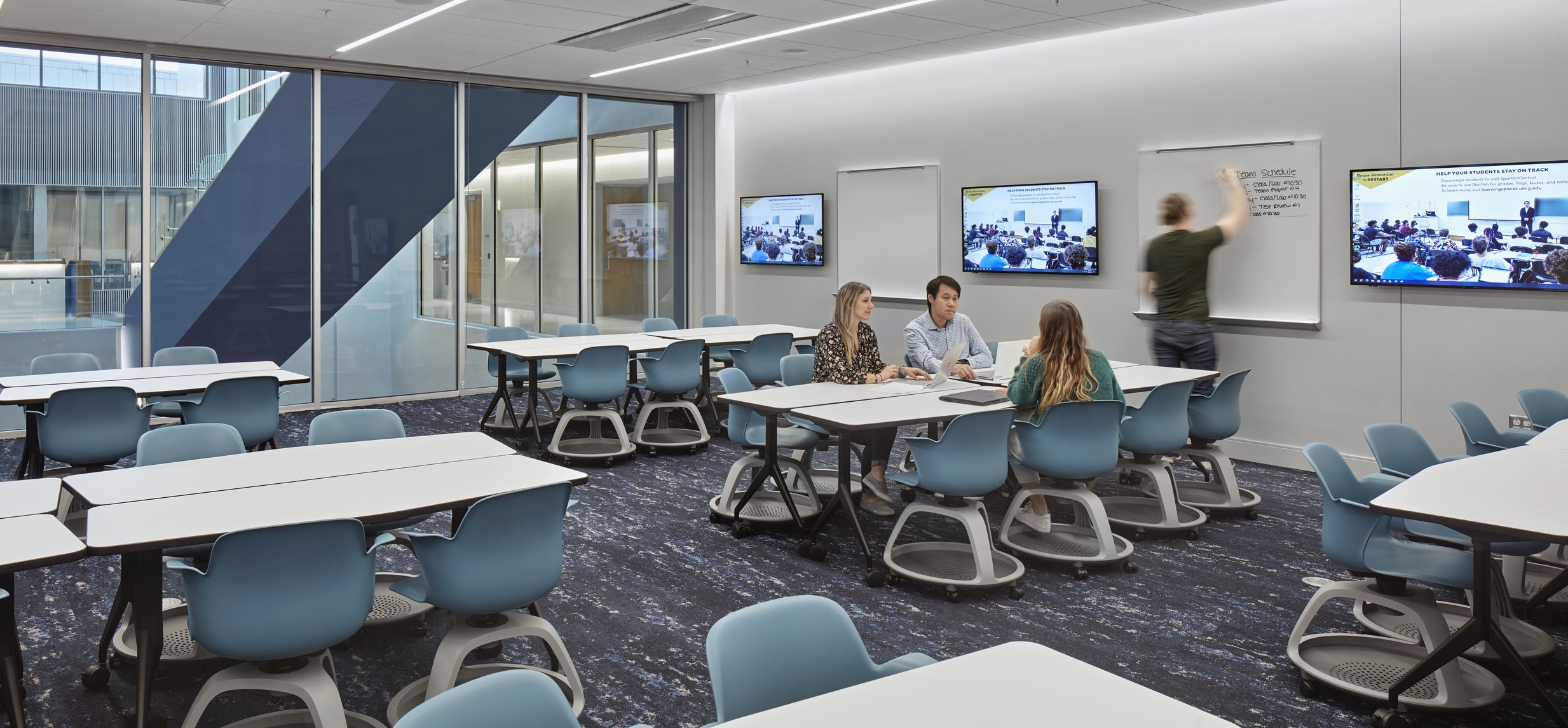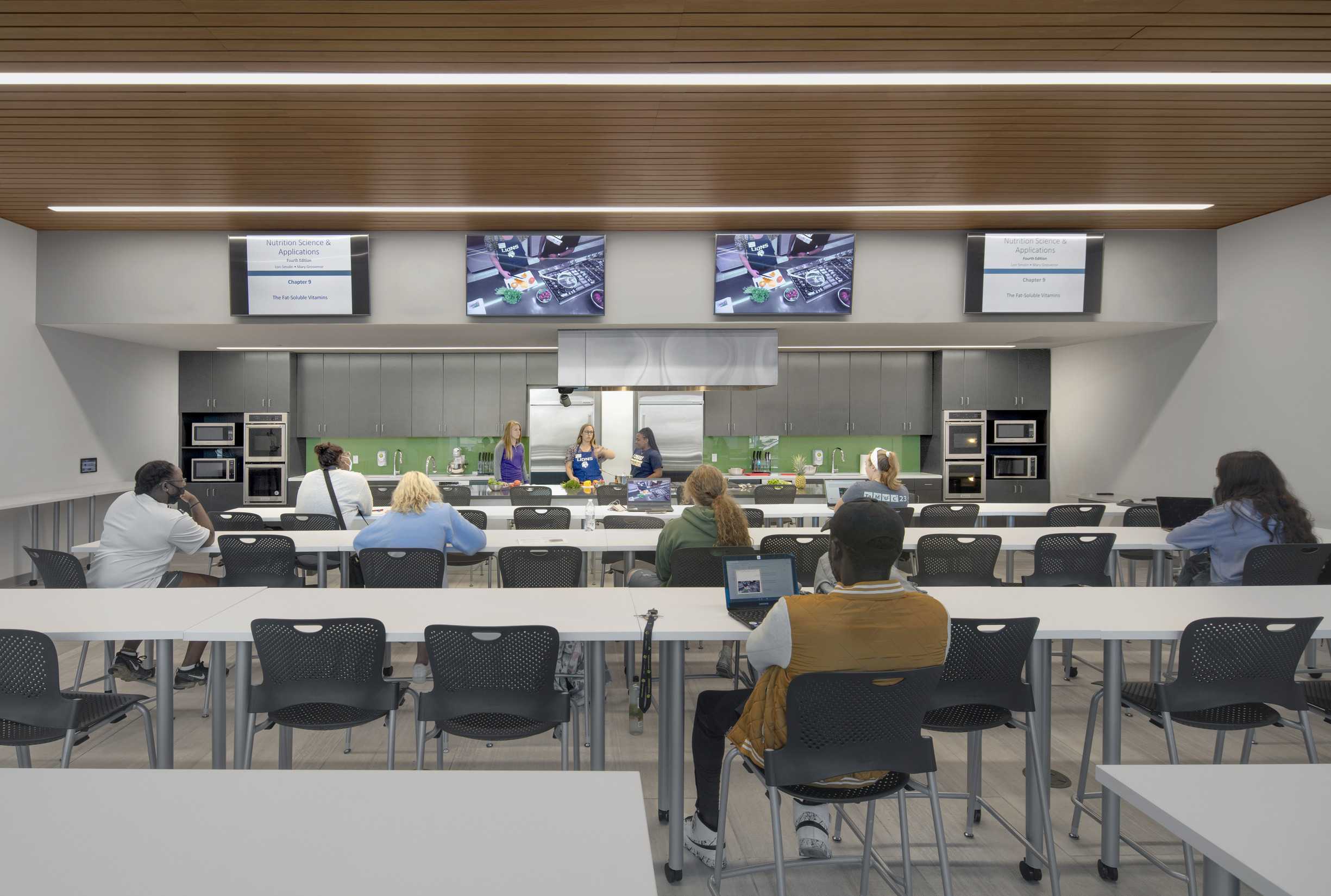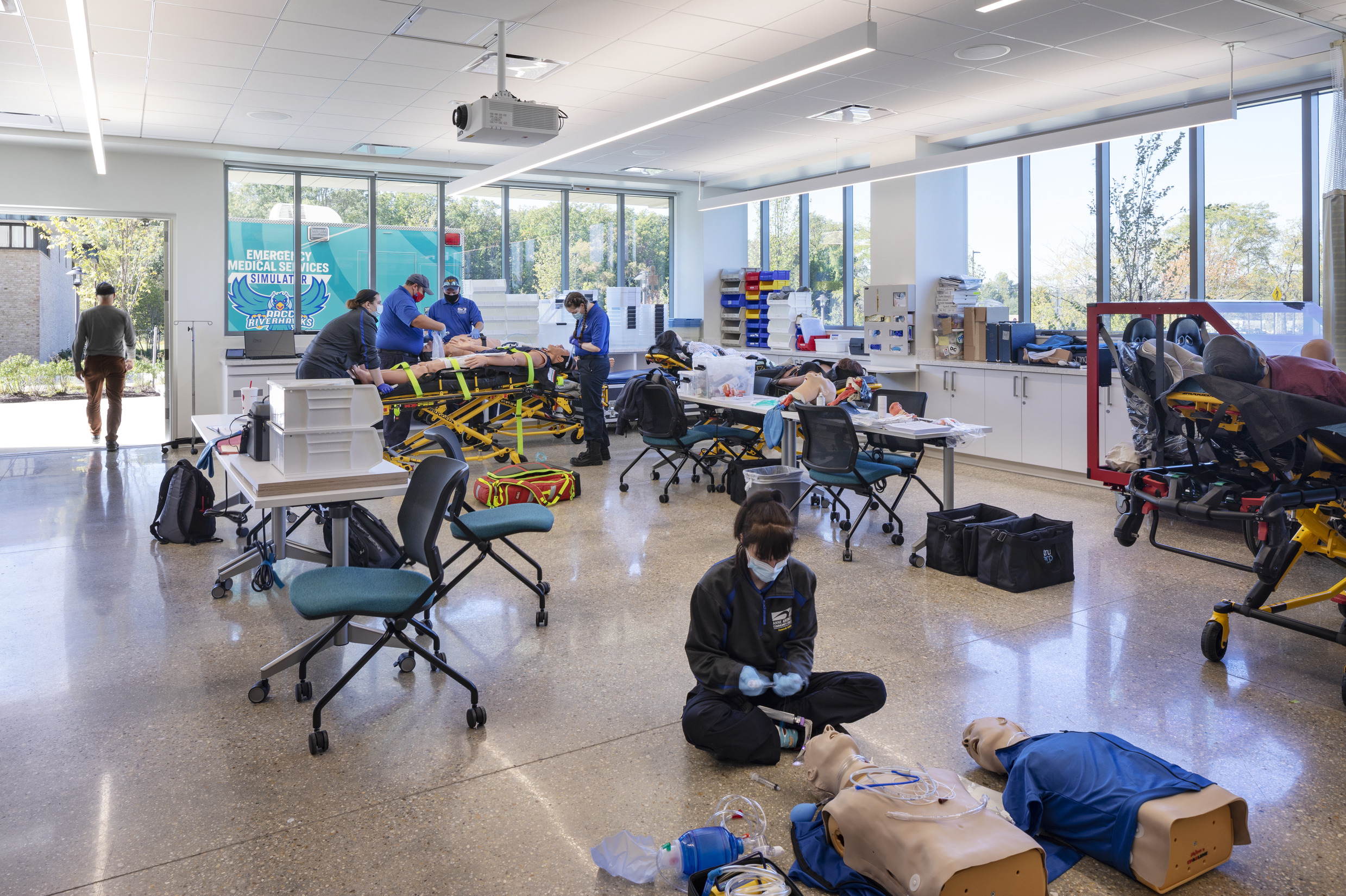How Can Design Support the AACN Essentials?
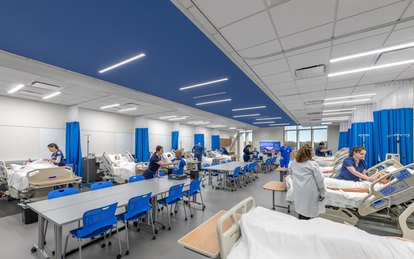
In 2021, the American Association of Colleges of Nursing (AACN) released "The Essentials: Core Competencies for Professional Nursing Education", suggesting significant changes to nursing education that aligns with changes in our rapidly evolving healthcare system.
The Essentials is built on the principles of competency-based education, acknowledging the student as the center of the learning experience and emphasizing recent developments in pedagogy and instructional technology. Learners are prepared to provide quality care; advocate for patients, families, and communities; and promote health equity and social justice.
As architects and designers of environments for health education, we are passionate about creating spaces that enrich the student experience and support the transformations indicated by the Essentials. SmithGroup studied the Essentials and identified the most significant impacts on the physical environment.
01 | Design for interprofessional partnership at all scales
Interprofessional education (IPE) continues to be a critical component of nursing education, but often faces challenges like siloed departments, lack of curricular integration, and rigid space and resource allocation.
The AACN Essentials (Domains 1, 6, and 10) removes the curricular barrier by emphasizing the understanding and application of transdisciplinary skillsets to foster a spirit of inquiry in nursing practice. The next step is for institutions to align physical space planning and design to encourage IPE activities.
Adapt Existing Space
While most institutions will not have the luxury of designing new buildings, they can assess underutilized or specialized space within existing facilities to find ways to support IPE:
- Retrofit simulation spaces to enable a wide array of scenarios applicable for multiple disciplines and interdisciplinary teaming exercises.
- Maximize flat floor classrooms to host activities that support interprofessional discussion including presentations, workshops, and speakers.
- Ensure the availability and ease of access to storage space to support multiple modalities.
Encourage Peer-to-Peer and Faculty-Student Interaction
Informal spaces promote peer-to-peer interaction outside of formal learning environments. Allowing student access to unscheduled classrooms and conference rooms distributes this collaboration throughout existing facilities. Entry lobbies can showcase the link between nursing and other disciplines through pin up areas and digital displays to spark conversation.
Co-mingling students and faculty engenders a spirit of inquiry. When faculty workspace is separate from the learning spaces, this limits interaction. If we expand the definition of the work environment, we can create opportunities for work or consultation spaces located near students. Look for spaces outside of faculty offices for small group collaboration, bridging the divide between student-owned and faculty-owned space.
Optimize Campus Adjacencies
Site selection for a new facility is an opportunity to optimize adjacency to complementary programs or specialized facilities that nursing programs may use and alleviate space pressures in planning. This includes social spaces and large-scale classrooms or event spaces that encourage students to engage with peers in other disciplines.
The facility itself can be planned for adjacencies between space types and experiences, not just departments, to bring stakeholders together.
02 | Foster Personal Resiliency in Psychologically Safe Spaces
In response to the nursing shortage, nursing educators acknowledge a need to foster personal resilience in learners, with the goal of creating a workforce of happier, healthier nurses. The Essentials acknowledges this need in many ways, but none are clearer than Competency 10.1: “Demonstrate a commitment to personal health and well-being”, with sub-competencies that directly reference self-care, wellness, and resiliency.
Design for Wellness
Many schools have acknowledged the link between wellbeing and environment by providing rooms for respite and wellness. Dedicated wellness spaces can take on many forms such as meditation rooms, game rooms, or spaces for movement. All these spaces support intentional self-care, a skill that is critical to developing resilient learners. We can meaningfully increase wellness in learning communities by increasing access to natural light in shared spaces, providing more spaces outdoors, and promoting movement in the way we organize spaces.
Support Successful Feedback
In the AACN’s Guiding Principles for Competency-Based Education, instructors are reminded that low-stakes feedback should immediately follow practice. Environments to support this feedback are rarely adjacent to environments for practice, which limits the ability to provide feedback. Include semi-shared, acoustically private spaces for natural conversation within or adjacent to practice environments, creating opportunity for fast feedback that feels natural. Factors like interpersonal distance in furniture arrangements and body buffer zones can impact the way we receive feedback and communicate with others.
03 | Cultivate empathy through intentional design and community connection
The Essentials emphasize Person-Centered Care in Domains 2 and 9, requiring nurses to understand the social determinants of health and integrate principles of equity and diversity into their practice to help them connect with individual patients. Institutions are expanding requirements for community engagement and interdisciplinary coursework to cultivate empathy and teach holistic health strategies, while also inviting the community in to break barriers.
These experiences can benefit from multiple scales of space and modalities, including formal presentations in technology-rich spaces where lessons learned can be recorded and revisited as well as impromptu discussions in informal lounges. Opportunities to display artifacts from community engagements can be built into a variety of spaces. To draw the community in, the institution can engage the community and identify opportunities to address an existing need such as a recreation or community center, nutrition labs or outpatient clinics.
Use Technology to Cultivate Empathy
To ensure that students understand the diversity of communities and patients, simulation spaces should go beyond the standardized patient to provide a range of fidelities including a fully virtual or augmented reality “holodeck” that can simulate care in any environment. This is especially important when considering education for home care. If students are exposed to a wide variety of environments during their education, they will be more prepared to adjust to the realities they encounter.
04 | Support experiential learning, everywhere
Experiential learning, from virtual simulation to standardized patient encounters, is fundamental to nursing education, helping to narrow the gap between theory and practice. In the AACN’s Guide to Curricular Transition, educators are encouraged to “create opportunities for experiential learning in the classroom.”
Flat-floored, open classrooms without fixed furniture are often the easiest place to accommodate experiential learning. In this environment, learners can be organized into small groups for role-playing activities to build and enhance critical thinking skills.
In larger spaces, technology can be seamlessly integrated to support speech reinforcement as students share out findings with the class. Flat-floored, open learning environments can more easily support accessible and equitable content delivery, as they provide the greatest flexibility for organizing learners and maneuvering around the space for learners with limited mobility.
Development of foundational clinical skills, like drawing blood or inserting catheters, can extend outside of the traditional skills lab. By design, many task trainers are mobile – yet most classrooms are not designed to support their use. By providing deeper tables, adjustable work surfaces, and cleanable materials, the environment allows instructors the flexibility to incorporate skills-based experiential learning in a traditional classroom environment.
Use Technology Everywhere
The use of simulation in virtual reality (VR) environments provides an opportunity to bring experiential learning anywhere. As technology improves, and as new learners are increasingly comfortable with it, the ability for VR simulation to improve learning outcomes may increase too. While this type of learning encounter might be best supported in the flat-floored, open environments described above, other classrooms may support this pedagogy with limited alteration.
What if we viewed learning environments, traditionally thought of as dedicated spaces like classrooms, simulation labs, skills labs, and auditoria, as a more dynamic spectrum of space? Instead of bringing experiential learning into the classroom, could teaching and learning occur in new environments altogether?
Conclusion
As institutions adopt The Essentials, there is significant opportunity in both existing and new facilities to align the physical environment to these updated priorities. The key is to understand that the learning experience is not relegated to the four walls of the classroom. Rather, it is the sum of an individual’s experiences with their faculty and peers on campus and within their surrounding communities that will create the next generation of skilled and empathetic healthcare providers.
